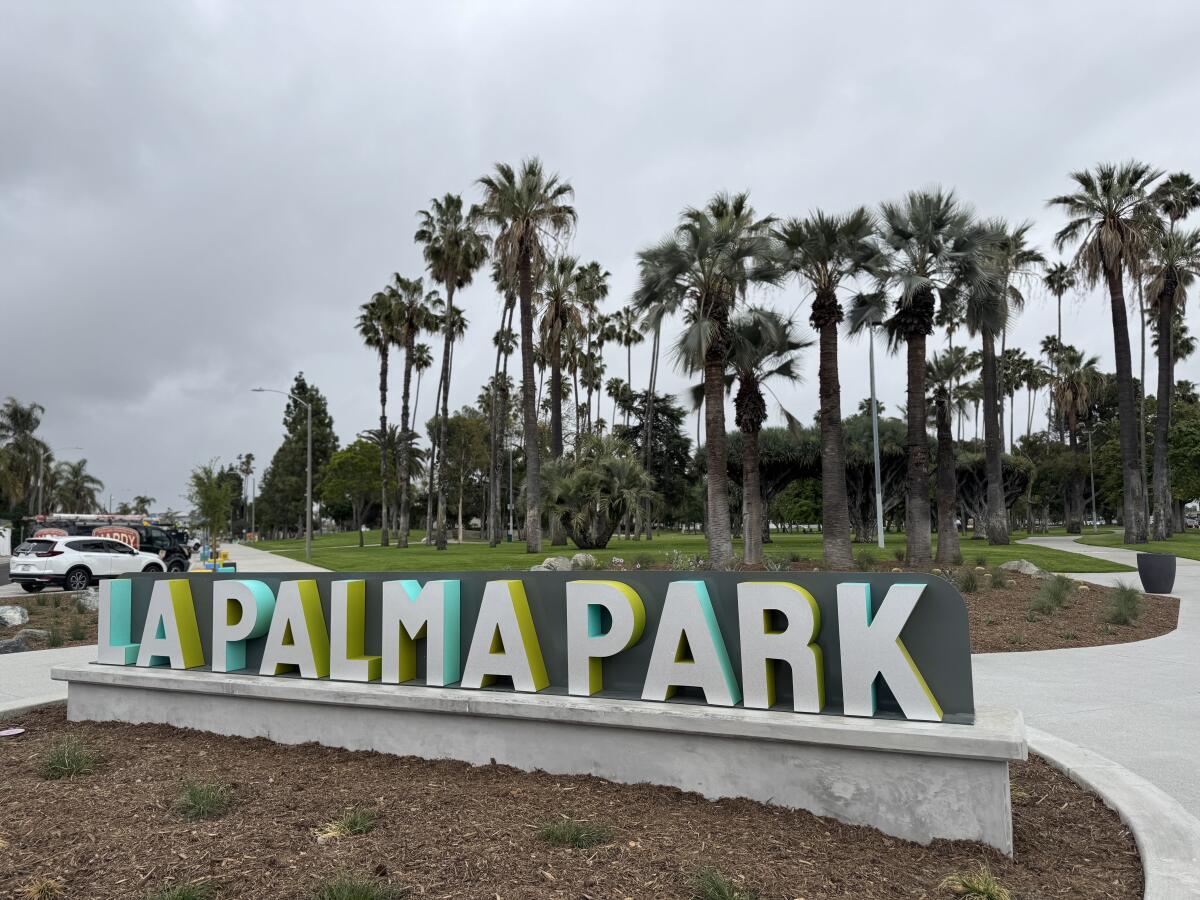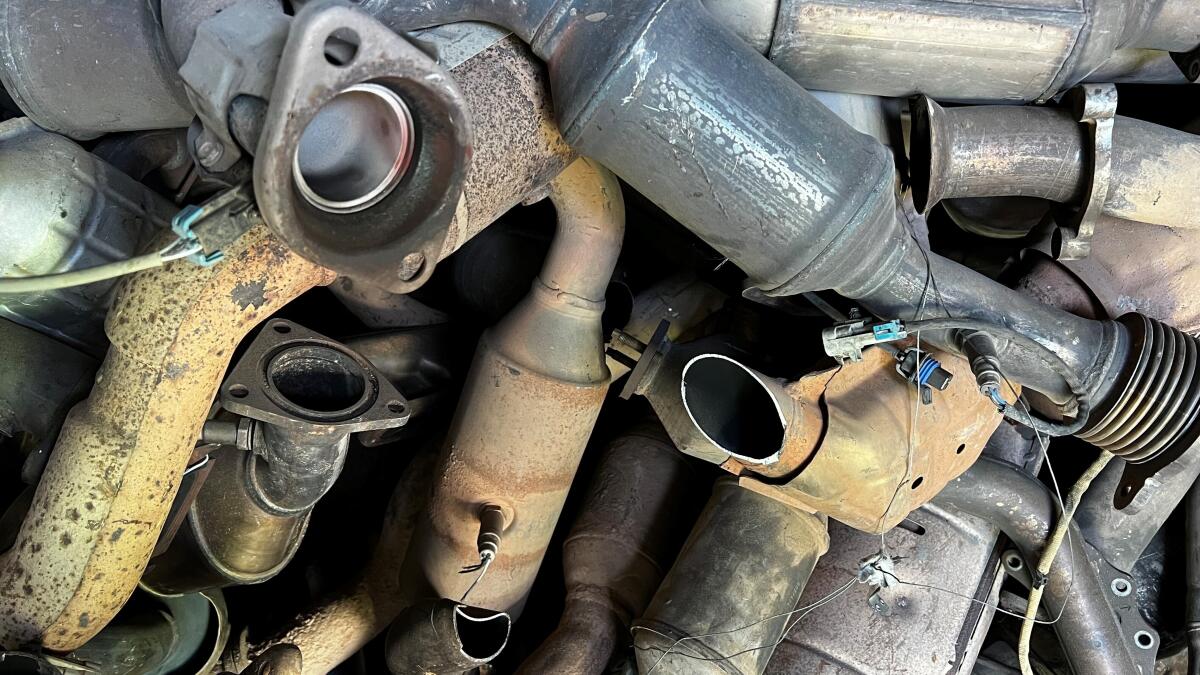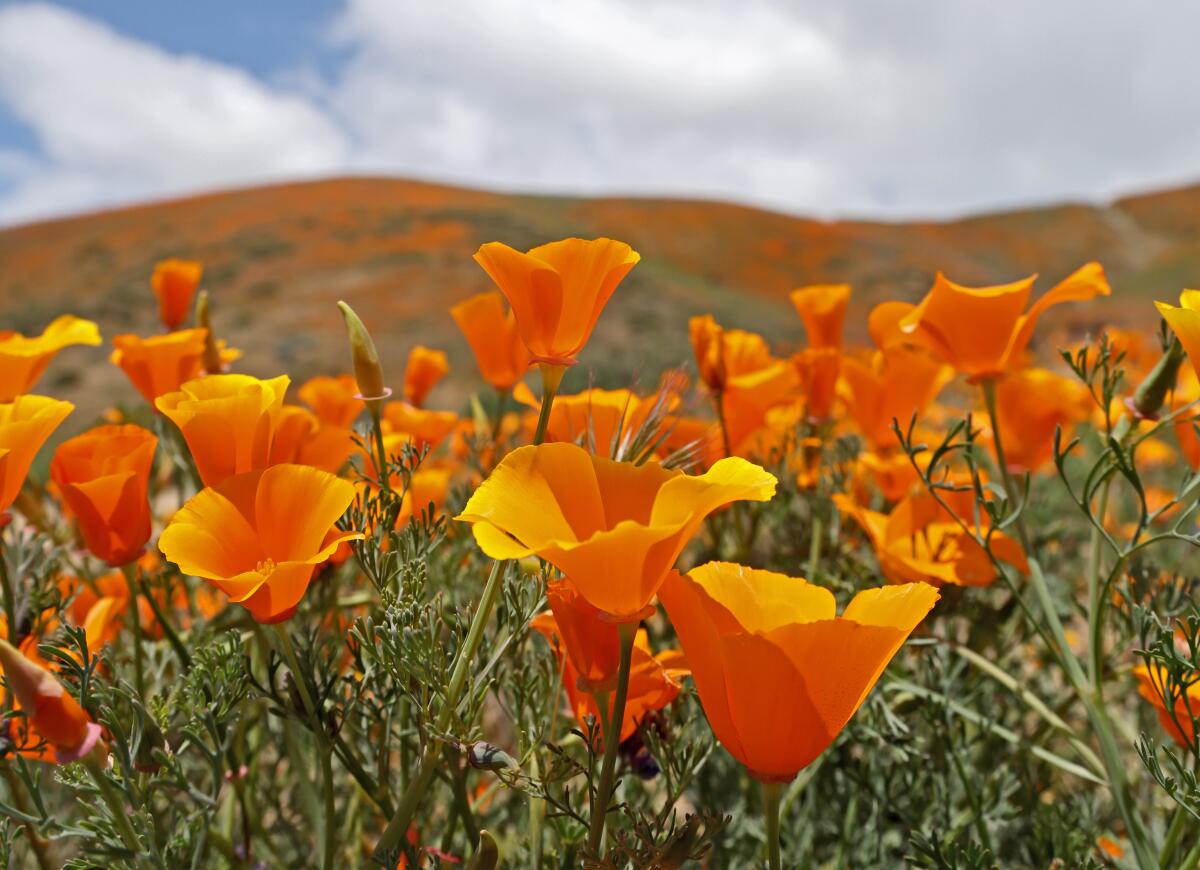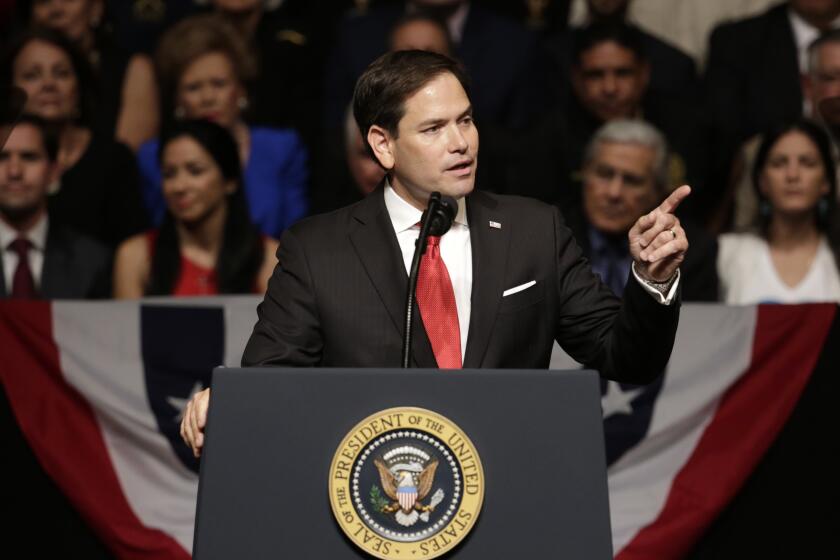‘Auf Wiedersehen’ to another part of Anaheim’s German heritage

- Share via
Good morning. Here’s what you need to know to start your day. I’m Times California columnista Gustavo Arellano, writing from my native Orange County.
- “Auf Wiedersehen” to another part of Anaheim’s German heritage
- Republicans in Washington mull more cuts
- Where to find Sri Lankan food in L.A.
- And here’s today’s e-newspaper.
You're reading the Essential California newsletter
The most important California stories and recommendations in your inbox every morning.
You may occasionally receive promotional content from the Los Angeles Times.
Anaheim loses one of the last vestiges of its Teutonic roots
For nearly 50 years, drivers exiting the 91 Freeway at Harbor Boulevard toward Anaheim were greeted by a pair of wooden signs that spoke to my beloved hometown’s past and present.
At the northwest corner of La Palma Park, three stone columns were connected by wooden planks that bore seals of the local chapters of do-gooder organizations like the Lions Club, Rotary International and the League of United Latin American Citizens.
The top boards read “Wilkommen in Anaheim 1857” and “Welcome to Anaheim” in white, somewhat-Gothic letters, a nod to the city’s founding by German immigrants who wanted to create a winemaking colony but instead started the best damn city in Southern California (sorry, Bradbury).
Built in 1976 with money raised via garage sale, the “Wilkommen” sign stood as Anaheim transformed from a working-class white town to one with large populations of Middle Easterners, Romanians, Pacific Islanders and especially Latinos, who now comprise the majority of the city’s residents.
The “Welcome” guidepost embodied a city where multiculturalism was embedded from the start. It became one of the last public vestiges (besides streets named after pioneers) of Anaheim’s Teutonic origins after the last local German restaurant closed in 2021 and the long-standing Phoenix Club moved up the 57 Freeway to Brea.
This past fall, the sign was removed.
I figured city workers stored it somewhere while La Palma Park — the second-oldest in Anaheim, and one where I grew up in because it was down the street from where I grew up — underwent a multimillion-dollar renovation. But when I drove down Harbor earlier this week, an ugly replacement now occupied the sign’s location.
The new marker, which went up last month, reads “La Palma Park” in sans-serif script. The front of each letter is painted gray; their sides alternate between lime green and turquoise tones. That color scheme is so jarring that I thought my eyes were short-circuiting. The whole thing sits on a slab of concrete, in a planter currently surrounded by wood chips.
A white sheet of paper has more personality than this weak-salsa excuse meant to greet people entering Orange County’s largest city.

Whenever I have a question about Anaheim, I always reach out to Councilmember Natalie Rubalcava, who represents the district where La Palma Park is located. My fellow Anaheim High Colonist (she’s class of 1996, I’m class of 1997) told me residents complained to her the moment the “Wilkommen” sign was removed. City staff did an internal review shortly after that to determine if it was worth keeping.
They determined it wasn’t.
“I’m disappointed that the original sign wasn’t saved,” Rubalcava said, acknowledging “some gaps in communication, including with my office.” She added that the city is working on a public display at La Palma Park that will honor the “Wilkommen” sign and commemorate Anaheim’s German heritage. The councilmember also said that she wants to pass a formal policy that will “establish a clear process before removal or alteration of potentially historical items.”
I’m glad Rubalcava is trying to make up for something that shouldn’t have happened and I’ll forgive her for telling me that the new sign “looks good and serves as a welcoming gateway to our beautiful city” — come on, Natalie, you’re cooler than that!
And Anaheim does have far more pressing problems than the fate of a collection of old sticks and stones: gangs, housing inequality, the recent sentencing of former Mayor Harry Sidhu for pleading guilty to obstruction of justice, and the ever-influential campaign dollars of Disneyland (did you know the word for “corruption” in German is Korruption? Now you do!)
But the destruction of the “Wilkommen” sign, in a city that usually cares more than most about its past, is just another sign of how folks pay attention to what they cherish in a city only after it’s too late — myself included. What did Joni Mitchell sing in “Big Yellow Taxi” again?
Today’s top stories

Republicans in Washington keep on cutting
- Trump’s proposed cuts to federal rental assistance would hit California hard.
- California environmental groups reel from EPA grant cancellations.
- Facing self-imposed budget cuts, Republicans in Congress mull the future of Medicaid.
- The White House has provided no details on the proposed tariffs on foreign-made movies or the plan to reopen Alcatraz as a prison.
In a new poll, Californians say they’re stressed about money
- Nearly half of California voters feel worse off economically than they were last year, and 54% felt less hopeful about their financial well-being
- When will Democratic lawmakers make California more affordable? Later, leaders say (via CalMatters)
Los Angeles County reported another measles case
- Officials renewed their call for residents to make sure they are vaccinated.
- Measles was first reported in the county from a resident who recently returned from Texas.
- Scientists say the U.S. is approaching a dangerous measles precipice.
L.A.’s fire recovery is not getting any easier
- Civic and business leaders called for a new local authority to oversee post-fire rebuilding
- Los Angeles County fire victims filed two more lawsuits against the Fair Plan.
- In the race to clean up Altadena, businesses are on their own.
Raises for airport and hotel workers could be put on hold
- The first of several wage hikes for airport and hotel workers were scheduled to go into effect on July 1, but a coalition of L.A. business leaders has urged the City Council to hold off.
- That’s because many are worried about the impact Trump’s tariffs will have on tourism.
What else is going on
- Nate Holden, a state senator and longtime councilman who fought for South L.A., died at 95
- San Francisco law enforcement veteran Bill Scott will become L.A. Metro’s first police chief.
- Black smoke poured out of the Sistine Chapel’s chimney — no new pope yet.
- An american tourist climbed over the fence at the Colosseum and impaled himself on a spike.
- The California State Bar’s botched rollout of a new exam could ultimately end up costing it an additional $5.6 million.
- A magnitude 3.2 earthquake off the coast sent weak shaking through Malibu and L.A.’s Westside.
- Netflix is about to look a lot different for viewers. Here’s how.
Get unlimited access to the Los Angeles Times. Subscribe here.
Commentary and opinions
- Alcatraz as a prison? Columnist Steve Lopez has a few other ideas for Trump to consider: What about a coliseum that features Jan. 6 patriots? Hearst Castle as the Western White House? And don’t forget Trump Tower Torrance.
- If Gavin Newsom wants to be president, he’s got work to do, argues columnist Mark Z. Barabak, starting at home.
- Contributors Akaya Windwood and Bill McKibben argue that older Americans are Trump’s biggest nightmare
This morning’s must-reads

A family-run catalytic converter ring in Sacramento nets $38 million. Mom and two sons pleaded guilty. Tou Sue Vang ran a profitable family business in Sacramento with his brother, Andrew, and his mother, Monica Moua. But the lucrative family enterprise was illegal and involved buying stolen catalytic converters in a scheme that made more than $38 million for the family, according to authorities.
Other must-reads
- Meet the L.A. holistic doctor and wellness influencer who is Trump’s choice for surgeon general
- This superfan is buying VHS copies of ‘The Mummy.’ The size of his collection is shocking.
How can we make this newsletter more useful? Send comments to essentialcalifornia@latimes.com.
For your downtime

Going out
- 🍽️ Where to find Sri Lankan food in L.A.? Inside the kitchen bringing string hoppers to East Hollywood.
- 🎨 Inspired by falling terra-cotta roof tiles, Jackie Castillo created a multimedia installation for ICA with the help of her father.
Staying in
- 📖 What would Malcolm X say about Trump? A new book argues his legacy is more important than ever.
- 📺 ‘Forever,’ on Netflix, modernizes a story about first love, vulnerability and heartbreak with its leads.
- 📺 Natasha Lyonne is back as Charlie Cale in ‘Poker Face,’ Peacock’s murder mystery series, and for Season 2, Lyonne is adding director to her list of duties on the show.
- 🥗 Here’s a recipe for the ultimate carrot cake with cream cheese frosting.
- ✏️ Get our free daily crossword puzzle, sudoku, word search and arcade games.
A question for you: Last call for the best career advice you’ve gotten
Betty says: “HR is not your friend”
Joyce says: “Listening is not waiting for your turn to speak.” (We can all agree that one applies outside of work too)
Email us at essentialcalifornia@latimes.com, and your response might appear in the newsletter this week.
And finally ... your photo of the day
Show us your favorite place in California! Send us photos you have taken of spots in California that are special — natural or human-made — and tell us why they’re important to you.

Today’s great photo is from staff photo editor Raul Roa: It’s not a total bust for wildflowers. Find a hidden field of poppies right in L.A. County
Have a great day, from the Essential California team
Gustavo Arellano, California columnist
Karim Doumar, head of newsletters
Check our top stories, topics and the latest articles on latimes.com.
Sign up for Essential California
The most important California stories and recommendations in your inbox every morning.
You may occasionally receive promotional content from the Los Angeles Times.







